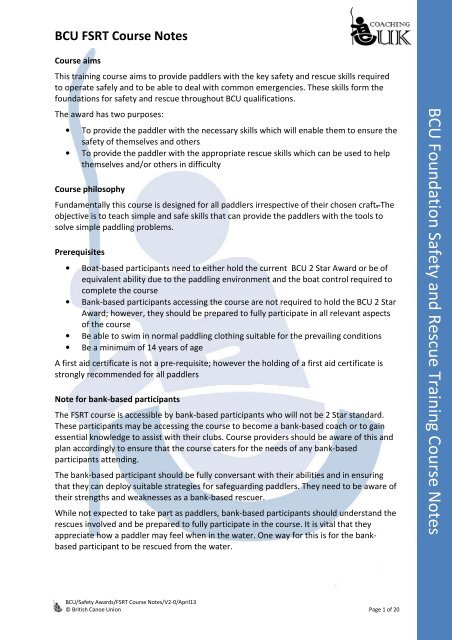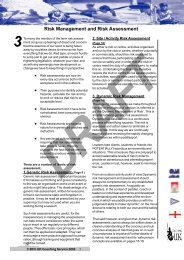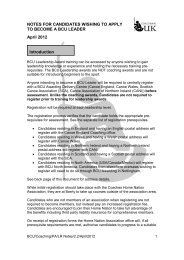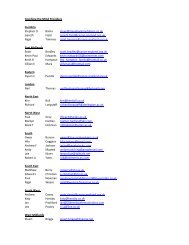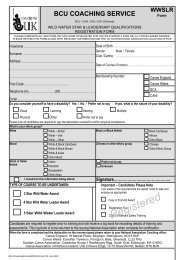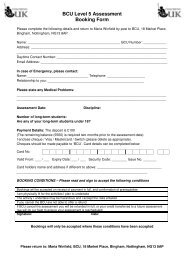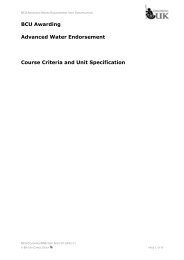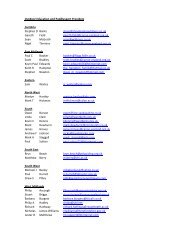FSRT Course Notes - Jersey Kayak Adventures
FSRT Course Notes - Jersey Kayak Adventures
FSRT Course Notes - Jersey Kayak Adventures
You also want an ePaper? Increase the reach of your titles
YUMPU automatically turns print PDFs into web optimized ePapers that Google loves.
BCU <strong>FSRT</strong> <strong>Course</strong> <strong>Notes</strong>Skills competency checklistAll participants should leave the <strong>FSRT</strong> course with a completed ‘skills competency checklist’(See page 19). The participants name, provider’s name, and date are completed along thetop.In the ‘Provider’ column the course provider ticks as appropriate if the participant is:• good in this area• competent• needs developmentParticipants do the same, in the ‘Participant’ column.The skills competency checklist is designed for giving participants a clear indication of theirstrengths and weaknesses, and areas where development is required. It is also designed tohelp participants reflect on their current abilities. It can also be used on other courses (e.g. 3Star, or Level 1 and 2 Coach <strong>Course</strong>s) to help the provider gain an insight into theparticipants previous level. It is therefore important that it is completed accurately for ALLparticipants, and that they are encouraged to keep a copy (in their logbook, if they haveone).<strong>Course</strong> Content1. General theory and planning1a. SafetySafety training for the paddlers:• Training to allow participants’ to move from dependence to independenceThe following topics to be covered:• Risks associated with paddlesport and the working environment• Practical ways to manage the risks• Safety features of the craft being used• Safety features of paddling clothing and other associated equipment• Water and environmental hazards such as water borne diseases, access andegress points, effects of weather has on the paddling conditions,hypothermia and exposure to wind and cold water• The use of signals that are clear and understood by all in the group• The ability to deal with emergencies and how to summon outside help• Manual handling issues, the ability to demonstrate safe lifting and carryingtechniques• The value of holding a first aid certificate which is up-to-dateBCU Foundation Safety and Rescue Training <strong>Course</strong> <strong>Notes</strong>BCU/Safety Awards/<strong>FSRT</strong> <strong>Course</strong> <strong>Notes</strong>/V2-0/April13© British Canoe Union Page 4 of 20
BCU <strong>FSRT</strong> <strong>Course</strong> <strong>Notes</strong>Decisions have to be made pretty quickly during a rescue and what has been set upat the initial safety chat can help out a great deal. Implementing appropriate controlmeasures:• Safety briefing to include boundaries, what to do in an emergency i.e.someone capsizesAccident and emergency plans• Where are the nearest phone/help/vehicle, first-aid and repair-kit? Whatspares do we have?Group management• Communication - how do I keep in contact with the group? The knowledgethat keeping it simple is best• Line of sight of each other - endeavouring to keep fellow paddlers in sight• Avoidance - where are the hazards and can we avoid them?• Position of most usefulness - where does the leader need to be to be themost use? Where do I need to be to be of most use for the team?The Clean Rope PrincipleThis principal should become a way of thinking for paddlers. Applying theseprinciples considerably reduces the risk of rope snagging and simplifies the ropesystems for rescues:• If you carry a rope, carry a knife• Remove any loops or knots from the end of your throw line - the loop in the'bag end' needs to be small enough to prevent a hand or foot passing throughit easily; good flotation within the bag also reduces the risk of snaggingIn all situations participants should be aware of reducing snagging possibilities.Paddlers should pay attention to their buoyancy aid, painters in canoes, tow linesand swim lines.1b. Rescue protocolsWhen dealing with rescue is important to follow the protocol:Self - Team - Victim - EquipmentThis protocol for prioritisation in the rescue situation is useful in helping would berescuers to remember that their first priority is to themselves, then to their team,then to the victim and lastly equipment. This should encourage rescuers to look atlow risk options first, discouraging a reckless approach to rescue.LOW RISKHIGH RISKBCU Foundation Safety and Rescue Training <strong>Course</strong> <strong>Notes</strong>SHOUT REACH THROW ROWBCU/Safety Awards/<strong>FSRT</strong> <strong>Course</strong> <strong>Notes</strong>/V2-0/April13© British Canoe Union Page 5 of 20
BCU <strong>FSRT</strong> <strong>Course</strong> <strong>Notes</strong>2. Bank-based rescues2a. Coach a swimmer (10m away) to shoreSHOUT - Giving clear and correct instructions the participant should get theswimmers attention and talk them from the water. Rescuers need to keep speakingthe whole way through the rescue, this both informs the casualty of what’shappening but can also keep their spirits up. If the participant needs to wade in thewater to help get nearer then there should be consideration of the risks associatedand the need to remember the self-team-victim-equipment protocol.2b. Rescue a swimmer (1m away) with a rigid aidREACH - Using a rigid reaching aid such as a paddle or canoe pole- the participantshould be taught to lower their centre of gravity to prevent being pulled into thewater. If a floating aid is used this must be thrown and land with arm reach of theswimmer.2c. Rescue a swimmer (10m away) using a throw-line (packed and unpacked)THROW:• Use a throwline to help extend reach and pull a casualty back to shore• The towline could also be used as could a length of rope or webbing• The participant should be taught first get the swimmers attention, give clearinstructions and then throw the line, landing within arm’s reach• The participant will then recover the swimmer to shore giving the correctinstructions to prevent injury in shallow water• The participant needs to be able to pack their throwline correctly• The participant needs to be able to coil an unpacked throwline and use thisto execute a rescue• Throwline rescues should land within reach of the casualty3. Boat-based rescues3a. Rescue a swimmer from the waterThe participant should be taught to approach the swimmer, stand-off, and give clearinstructions to the swimmer, ensure they have calmed down sufficiently toapproach, as the participant approaches they must provide the correct instructionfor a carry to shore. The participant will take care not to injure the swimmer inshallow water close to shore.The participant should be taught a range of techniques and must be able to showthey understand the benefits of each method and be able to choose the appropriatemethod for the craft they are paddling and the prevailing conditions. The importanceof having the casualty keeping a hold of the craft at all times should be stressed.BCU Foundation Safety and Rescue Training <strong>Course</strong> <strong>Notes</strong>BCU/Safety Awards/<strong>FSRT</strong> <strong>Course</strong> <strong>Notes</strong>/V2-0/April13© British Canoe Union Page 6 of 20
BCU <strong>FSRT</strong> <strong>Course</strong> <strong>Notes</strong>Throughout the rescue the rescuer should be talking to the casualty. These rescuescould include but not exclusive to the following:a. Bow carryb. Stern carryc. Towd. Assist the swimmer into/onto the CCK / OCK / OC / SOT / IKC / SUP3b. Rescue a capsized paddler using a deep-water rescueThe participant should be taught to approach the capsized paddler, give clearinstructions to the paddler to hold onto their boat.• The participant will need to show that they are aware of the need for theswimmer to hold on and the benefits of being able to see them, (this doesn’tmean that the swimmer can’t hold onto the stern)• The participant should be able to choose whether or not to put the swimmerinto/onto their craft during the rescue, this will be craft dependant• The participant should be able to show that they understand the pros andcons of the different methodsTraining should cover as many craft as possible and ensure that canoes and kayaksare covered on the training day:• All boat-based rescues must be practiced in canoe and kayakProviders are to facilitate that participants can problem solve at the end of thecourse so that they can find a solution to simple common paddling scenarios in flat /sheltered water regardless of the craft.Note - The importance of airbags should be emphasised throughout the course,however training needs to be provided to allow alternative rescue methods (e.g.towing, use of pump) for situations when airbags are not present or have beenpunctured. Manual handling considerations must be emphasised throughout.Closed cockpit kayak and open cockpit kayak• The participant should be taught how to deal with the following:a. Swamped kayaksb. Large cockpit kayaksc. <strong>Kayak</strong>s with or without bulkheadsd. With or without assistance from the swimmer or other group memberse. The ability to keep the paddles in contact with the rescuef. The ability to get the swimmer back into their kayak using a variety ofmethods• The participant must be shown and understand good manual handlingthroughout the rescue• The participant must note the need for the rescue to be done in a timelyfashion but not forgetting the self-team-victim-equipment protocolBCU Foundation Safety and Rescue Training <strong>Course</strong> <strong>Notes</strong>BCU/Safety Awards/<strong>FSRT</strong> <strong>Course</strong> <strong>Notes</strong>/V2-0/April13© British Canoe Union Page 7 of 20
BCU <strong>FSRT</strong> <strong>Course</strong> <strong>Notes</strong>Open canoe• The participant must be aware of the forces that are involved and take stepsto deal with the manual handling of the canoe• The participant should be taught how to deal with the following:a. Swamped canoes with or without airbagsb. With or without assistance from the swimmers or other group membersc. The ability to keep the paddles in contact with the rescued. The ability to get the swimmers back into their canoe using a variety ofmethodse. The effect that wind has on the canoe• The participant must note the need for the rescue to be done in a timelyfashion but not forgetting the self-team-victim-equipment protocolSit-on-top and stand up paddle board• The participant should be taught how to deal with the following:a. The ability to keep the paddles in contact with the rescueb. The effect that the wind has on Sit on Top’s and Stand up Paddle Boardsc. The ability to get the swimmers back onto their boat using a variety ofmethodsd. With or without assistance from the from the swimmer or other groupmembers• The participant must note the need for the rescue to be done in a timelyfashion but not forgetting the self-team-victim-equipment protocolInflatable kayak OR canoe• The participant should be taught how to deal with the following:a. The ability to keep the paddles in contact with the rescueb. The effect that the wind has on an inflatablec. The knowledge of the different craft and how that can change the type ofrescued. With or without assistance from the swimmer or other group memberse. The knowledge of how to prevent punctures during the rescue• The participant must note the need for the rescue to be done in a timelyfashion but not forgetting the self-team-victim-equipment protocol3c. Rescue an unconscious or entrapped paddler from their boatThe participant to show that they have the skills to do the following:• Rescuer in their boat reaches over and rights the upturned boat• The participant to be aware that they have the ability to enter the water toallow them to reach over or pull the casualty out of their boat• The ability to keep the paddles in contact with the rescue• The participant must be aware of what happens next once they have thecasualty upright• Maintaining an airway• Towing to shoreBCU Foundation Safety and Rescue Training <strong>Course</strong> <strong>Notes</strong>BCU/Safety Awards/<strong>FSRT</strong> <strong>Course</strong> <strong>Notes</strong>/V2-0/April13© British Canoe Union Page 8 of 20
BCU <strong>FSRT</strong> <strong>Course</strong> <strong>Notes</strong>3d. Use of towlines - recover an unaccompanied boat to the shoreParticipants need to know that a towline should:• Be quick to set up• Be quick to release• Be quick to resetThe participant should be taught to do the following:• Use improvised tow systems• Use purpose made tow linesThe participant needs to be aware of the pros and cons of towing. The participantneeds to understand the craft they are dealing with and where they have securepoints for attaching tow systems to. The participant should be aware of the pros andcons of towing from either the body or boat.3d. Use of towlines - recover an upright, but incapacitated paddler to the shoreThe participant needs to be aware that a towline should:• Be quick to set up• Be quick to release• Be quick to resetThe participant should be taught to do the following:• use improvised tow systems• use purpose made tow linesThe participant needs to understand the craft they are dealing with and where theyhave secure points for attaching tow systems to. The participant should also beaware of the pros and cons of:• towing from the body• towing from the boat• towing paired or rafted boats• effects of the weather on paired or rafted boats3e. Self-rescueFor all types of boats the participant should be able to capsize in a controlledmanner, keep in contact with all equipment and swim to shoreClosed Cockpit <strong>Kayak</strong>The participant should have been taught how to execute an Eskimo rescue:• Act as rescuer and rescuee• Paddle and bow presentation should be demonstratedOpen canoe, sit-on-top and S.U.P.• The participant should be able to exit their boat in deep water, leaving itupright and without losing contact with get back in/on• The use of swim lines if fitted should be usedBCU Foundation Safety and Rescue Training <strong>Course</strong> <strong>Notes</strong>BCU/Safety Awards/<strong>FSRT</strong> <strong>Course</strong> <strong>Notes</strong>/V2-0/April13© British Canoe Union Page 9 of 20
BCU <strong>FSRT</strong> <strong>Course</strong> <strong>Notes</strong>3f. All-in rescueParticipants should have been taught how to deal with an “all-in rescue”. This isusing a combination of the skills above with the addition of how to get the firstperson back in their boat.• Participants to be taught techniques for emptying the first boat - to includeemptying one boat over another up-turned boat, turning canoe or Sit-on-Topover and getting participant back in/on and then carrying on the rescues fromthere• Participants to be aware of the order that you get people back in at – coldest,strongest etc.4. Scenarios – unknown incidentDeal with a simple paddling incident involving up to two casualties; the key word issimple, e.g.:• Unconscious casualty in or out of their boat• Injured or unwell e.g. suffering from hypothermia• in difficulty e.g. a struggling swimmer or capsized paddler• Broken or lost paddlesOptionally, there can be an additional participant (with paddling skills up to 2 Star)who will assist as directed by the participant. Participants are expected to use firstaid techniques where appropriate. However, as holding a first aid certificate is not aprerequisite, participants should not be pulled up for poor first aid techniques,although their shortcomings should be pointed out and they should be stronglyencouraged to get a first aid certificate.Each participant must be in charge and demonstrate correct decisions throughoutthe training. Participants must not have prior knowledge of the incident.BCU Foundation Safety and Rescue Training <strong>Course</strong> <strong>Notes</strong>BCU/Safety Awards/<strong>FSRT</strong> <strong>Course</strong> <strong>Notes</strong>/V2-0/April13© British Canoe Union Page 10 of 20
BCU <strong>FSRT</strong> <strong>Course</strong> <strong>Notes</strong>Sample Boat-based ProgrammeThis course aims to provide all paddlers with the tools to solve simple paddling problems.This course aims to provide the participant with the key safety and rescue skills required tooperate safely and to be able to deal with common emergencies. The course will typicallytake place over a day and must include a minimum of 8 hours teaching time.Timing Session content Resources / Supporting <strong>Notes</strong>30 min Introduction and briefing• Welcome• Introduction to staff and participants• Outline of course and programme• Suite of BCU safety awards• Risk disclosure• Questions30 min Safety and rescue protocols• General theory – preparing for a paddle• Emergency plans and control measures• Self – Team – Victim – Equipment• Shout – Reach – Throw – Row (Low toHigh Risk)10 min Equipment issuesSubjects to cover:• Equipment for the day• <strong>FSRT</strong> syllabus and course notes• Programme• Skills competency checklist• <strong>FSRT</strong> syllabus and course notes• Programme• Sample equipment for working in thesheltered water environment• Health and safety PPEOn WaterPractice time to be adjusted accordingly to ensure that all parts are covered30 min Group management• Safety brief before going afloat• Use of CLAP while paddling30 min Shout and reach rescues• Shout session focusing on use of bodylanguage as well as voice• Reaching session focusing onmaintaining own safety as a priority30 min Throw rescues• Time spent on land and then waterusing ropes in and out of the bags30 min Picking up swimmers using boats• Participants to use a variety of tacticsdepending on crafts available• Tutors to demo examples of safety briefsincluding boundaries and facilitate use ofCLAP while on simple paddle• Canoe paddles• <strong>Kayak</strong> paddles• Canoe poles• Tutors to consider setting a buoy out as atarget before putting swimmers in thewater• Tutors to ensure there are a variety ofdifferent types of throwlines available• Tutors to ensure that participants havetactics for both canoes and kayaks andexperience different types of solutionsBCU Foundation Safety and Rescue Training <strong>Course</strong> <strong>Notes</strong>BCU/Safety Awards/<strong>FSRT</strong> <strong>Course</strong> <strong>Notes</strong>/V2-0/April13© British Canoe Union Page 11 of 20
BCU <strong>FSRT</strong> <strong>Course</strong> <strong>Notes</strong>60 min Deep water rescues• Participants to have demonstrations ofcanoe to canoe rescue• Participants to have demonstration ofkayak to kayak rescue• Participants to practice in small groupsrescuing like to like crafts30 min Deep water rescues - getting back in / oncraft• Participants to be shown and thenpractice a variety of ways of getting outthe water60 min Towing and assisting• Participants to be shown a variety ofmethods for recovering boats• Participants to be shown a variety ofdifferent types of towing systems• Participants to practice towing andassisting others using equipment andimprovised systems60 min Self-rescues & rescueunconscious/entrapped paddler• Participants to have time to exploreand be shown methods for selfrescues.These can include swim ashoreas well as Eskimo rescue in closedcockpit kayaks• Participants to explore methods forrescuing unconscious or entrappedpaddlers20 min All-in rescue• An all-in rescue to be set up with smallteams30 min Scenarios• Scenarios should be set up to highlightthe days learning points• Bank and boat-based rescues to beincluded30 min Review of day• Learning points• Action plans• Complete skills competency checklists• Tutors to ensure that there are enoughcanoes and kayaks for the participants towork in small teams• Tutors to ensure that the participantshave the ability to problem solve if theyhad other craft available• Tutors to have available different types ofcraft so that the participants can practicegetting out of the water• Tutors to have tapes available for stirruprescues• Towing systems for canoes and kayaks• Painters for canoes• Extra lengths of tapes and slings• Tutors to ensure that the participantshave time to practice in shallow water first• Tutors to set up an all-in rescue scenario• The importance of the safety protocolsand tactics already explored shouldn’t beforgotten• Tutors to use this as an opportunity tohighlight the days learning and also toensure that the participants have problemsolving abilities to deal with simplepaddling scenarios• Tutors to spend time looking at what hascome out of the day and highlightingwhere next with the participants• Tutors to have the skills competencychecklists for the participantsBCU Foundation Safety and Rescue Training <strong>Course</strong> <strong>Notes</strong>BCU/Safety Awards/<strong>FSRT</strong> <strong>Course</strong> <strong>Notes</strong>/V2-0/April13© British Canoe Union Page 12 of 20
BCU <strong>FSRT</strong> <strong>Course</strong> <strong>Notes</strong>Sample Bank-based ProgrammeThis course aims to provide all paddlers with the tools to solve simple paddling problems.This course aims to provide the participant with the key safety and rescue skills required tooperate safely and to be able to deal with common emergencies. Providers to consider theuse of paddlers to act as the swimmer in bank-based courses. The course will typically takeplace over a day and must include a minimum of 8 hours teaching time.Timing Session and Content Resources / Supporting <strong>Notes</strong>30 min Introduction and briefing• Welcome• Introduction to staff and participants• Outline of course and programme• Suite of BCU safety awards• Risk disclosure• Questions30 min Safety and rescue protocols• General theory – preparing for apaddle• Emergency plans and controlmeasures• Self – Team – Victim – Equipment• Shout – Reach – Throw – Row (Low toHigh Risk)• Bank-based safety and rescueprocedures10 min Equipment issuesSubjects to cover:• Equipment for the day• Health and safety PPE• <strong>FSRT</strong> syllabus and course notes• Programme• Skills competency checklist• <strong>FSRT</strong> syllabus and course notes• Programme• Sample equipment for working in thesheltered water environmentBy / On WaterPractice time to be adjusted accordingly to ensure that all parts are covered30 min Group management• Safety brief before going afloat• Use of boundaries and managementfrom the bank• Use of CLAP while paddling30 min Shout and reach rescues• Shout session focusing on use of bodylanguage as well as voice• Reaching session focusing onmaintaining own safety as a priority30 min Throw rescuesTime spent on land and then water usingropes in and out of the bags• Tutors to demo examples of safety briefsincluding boundaries• Canoe paddles• <strong>Kayak</strong> paddles• Canoe poles• Tutors to consider setting a buoy out as atarget before putting swimmers in thewater• Tutors to ensure there are a variety ofdifferent types of throwlines availableBCU Foundation Safety and Rescue Training <strong>Course</strong> <strong>Notes</strong>BCU/Safety Awards/<strong>FSRT</strong> <strong>Course</strong> <strong>Notes</strong>/V2-0/April13© British Canoe Union Page 13 of 20
BCU <strong>FSRT</strong> <strong>Course</strong> <strong>Notes</strong>30 min Picking up swimmers using boatsParticipants to see a variety of tacticsdepending on crafts available60 min Deep water rescues• Participants to have demonstrations ofcanoe to canoe rescue• Participants to have demonstration ofkayak to kayak rescue30 min Deep water rescues - getting back in / oncraft• Participants to be shown a variety ofways of getting out the water60 min Towing and assisting• Participants to be shown a variety ofmethods for recovering boats• Participants to be shown a variety ofdifferent types of towing systems60 min Self-rescues & rescueunconscious/entrapped paddler• Participants to have been shown avariety of ways of achieving this. Thesecan include swim ashore as well asEskimo rescue in closed cockpit kayaks• Participants to explore methods forrescuing unconscious or entrappedpaddlers20 min All-in rescue• Participants to have an appreciation ofwhat this entails30 min Scenarios• Scenarios should be set up to highlightthe days learning points• Bank and boat-based rescues to beincluded• Tutors to ensure that participants havetactics for both canoes and kayaks andexperience different types of solutions• Tutors to be paddler throughout• Tutors to ensure that there are sufficientdemos of the required standard and thatthe participants are aware of theirlimitations but also their role in therescue• Tutors to consider having the participantsas the paddler being rescued• Tutors to ensure that the participantshave the ability to problem solve if theyhad other craft available• Tutors to have available different types ofcraft so that the participants can see thevariety of ways of getting out of the water• Tutors to consider having the participantsas the paddler being rescued• Tutors to have tapes available for stirruprescues• Towing systems for canoes and kayaks• Painters for canoes• Extra lengths of tapes and slings• Tutors to ensure that the participants areaware of their limitations within the selfrescuesand have tactics to be able to aidpaddlers complete a self-rescue• Tutors to consider that the participantshave time to practice in shallow waterfirst• Tutors are required to have the ability toshow the participants an all-in rescue• This could be through a group of paddlersor through a DVD• Participants are to explore the learninghighlighted through the course andrecognise good practice• Tutors to use this as an opportunity tohighlight the days learning and also toensure that the participants haveproblem solving abilities to deal withsimple paddling scenariosBCU Foundation Safety and Rescue Training <strong>Course</strong> <strong>Notes</strong>BCU/Safety Awards/<strong>FSRT</strong> <strong>Course</strong> <strong>Notes</strong>/V2-0/April13© British Canoe Union Page 14 of 20
BCU <strong>FSRT</strong> <strong>Course</strong> <strong>Notes</strong>30 min Review of day• Learning points• Action plans• Complete skills competency checklists• Tutors to spend time looking at what hascome out of the day and highlightingwhere next with the participants• Tutors to have the skills competencychecklists for the participantsBCU Foundation Safety and Rescue Training <strong>Course</strong> <strong>Notes</strong>BCU/Safety Awards/<strong>FSRT</strong> <strong>Course</strong> <strong>Notes</strong>/V2-0/April13© British Canoe Union Page 15 of 20
BCU <strong>FSRT</strong> <strong>Course</strong> <strong>Notes</strong>Sample Combined ProgrammeThis course aims to provide all participant with the tools to solve simple paddling problems.This course aims to provide the participant with the key safety and rescue skills required tooperate safely and to be able to deal with common emergencies. Providers to consider theuse of paddlers to act as swimmers in bank-based courses. The course will typically takeplace over a day and must include a minimum of 8 hours teaching time.Timing Session and Content Resources / Supporting <strong>Notes</strong>30 min Introduction and briefing• Welcome• Introduction to staff and participants• Outline of course and programme• Suite of BCU safety awards• Risk disclosure• Questions30 min Safety and rescue protocols• General theory – preparing for apaddle• Emergency plans and controlmeasures• Self – Team – Victim – Equipment• Shout – Reach – Throw – Row (Low toHigh Risk)10 min Equipment issuesSubjects to cover:• Equipment for the day• Health and safety PPE• <strong>FSRT</strong> syllabus and course notes• Programme• Skills competency checklist• <strong>FSRT</strong> syllabus and course notes• Programme• Sample equipment for working in thesheltered water environmentBy / On WaterPractice time to be adjusted accordingly to ensure that all parts are covered30 min Group management• Safety brief before going afloat• Use of CLAP while paddling• Use of boundaries and managementfrom the bank30 min Shout and reach rescues• Shout session focusing on use of bodylanguage as well as voice• Reaching session focusing onmaintaining own safety as a priority30 min Throw rescues• Time spent on land and then waterusing ropes in and out of the bags30 min Picking up swimmers using boats• Participants to see / use a variety oftactics depending on crafts available• Tutors to demo examples of safety briefsincluding boundaries and facilitate use ofCLAP while on simple paddle• Canoe paddles• <strong>Kayak</strong> paddles• Canoe poles• Tutors to consider setting a buoy out as atarget before putting swimmers in thewater• Tutors to ensure there are a variety ofdifferent types of throwlines available• Tutors to ensure that participants havetactics for both canoes and kayaks andexperience different types of solutionsBCU Foundation Safety and Rescue Training <strong>Course</strong> <strong>Notes</strong>BCU/Safety Awards/<strong>FSRT</strong> <strong>Course</strong> <strong>Notes</strong>/V2-0/April13© British Canoe Union Page 16 of 20
BCU <strong>FSRT</strong> <strong>Course</strong> <strong>Notes</strong>60 min Deep water rescues• Participants to have demonstrations ofcanoe to canoe rescue• Participants to have demonstration ofkayak to kayak rescue• Participants to practice in small groupsrescuing like to like crafts30 min Deep water rescues - getting back in / oncraft• Participants to be shown and thenpractice a variety of ways of gettingout the water60 min Towing and assisting• Participants to be shown a variety ofmethods for recovering boats• Participants to be shown a variety ofdifferent types of towing systems• Participants to practice towing andassisting others using equipment andimprovised systems60 min Self-rescues & rescueunconscious/entrapped paddler• Participants to have time to exploreand be shown methods for selfrescues.These can include swimashore as well as Eskimo rescue inclosed cockpit kayaks• Participants to explore methods forrescuing unconscious or entrappedpaddlers20 min All-in rescue• An all-in to be set up with small teams30 min Scenarios• Scenarios should be set up to highlightthe days learning points• Bank and boat-based rescues to beincluded• Tutors to ensure that there are sufficientdemos of the required standard that thebank-based participants are aware oftheir limitations but also their role in therescue• Tutors to ensure that there are enoughcanoes and kayaks for the participants towork in small teams• Tutors to consider having the bank-basedparticipants being rescued• Tutors to ensure that the participantshave the ability to problem solve if theyhad other craft available• Tutors to consider having the bank-basedparticipants being rescued• Tutors to have available different types ofcraft so that the participants can practicegetting out of the water• Tutors to have tapes available for stirruprescues• Towing systems for canoes and kayaks• Painters for canoes• Extra lengths of tapes and slings• Tutors to ensure that the participantshave time to practice in shallow waterfirst• Tutors to ensure that the bank-basedparticipants are aware of their limitationswithin these rescues and have tactics tobe able to aid paddlers complete a selfrescue• Tutors to set up an all-in rescue scenario• The importance of the safety protocolsand tactics already explored shouldn’t beforgotten• Tutors to use this as an opportunity tohighlight the days learning and also toensure that the participants haveproblem solving abilities to deal withsimple paddling scenariosBCU Foundation Safety and Rescue Training <strong>Course</strong> <strong>Notes</strong>BCU/Safety Awards/<strong>FSRT</strong> <strong>Course</strong> <strong>Notes</strong>/V2-0/April13© British Canoe Union Page 17 of 20
BCU <strong>FSRT</strong> <strong>Course</strong> <strong>Notes</strong>30 min Review of day• Learning points• Action plans• Complete skills competency checklists• Tutors to spend time looking at what hascome out of the day and highlightingwhere next with the participants• Tutors to have the skills competencychecklists for the participantsBCU Foundation Safety and Rescue Training <strong>Course</strong> <strong>Notes</strong>BCU/Safety Awards/<strong>FSRT</strong> <strong>Course</strong> <strong>Notes</strong>/V2-0/April13© British Canoe Union Page 18 of 20
<strong>FSRT</strong> – Skills Competency ChecklistName: Provider: Date:SkillsStrongParticipantCompetentNeedsdevelopingStrongProviderCompetentNeedsdevelopingEssential knowledge for all participantsPersonal paddling 2 Star skills(boat-based)Deploying strategies forsafeguarding paddlers (bank-based)Rescue a swimmer from the waterRescue a capsized paddler using adeep water rescue (canoe)Rescue a capsized paddler using adeep water rescue (kayak)Rescue an unconscious or entrappedpaddler from their boatUse of purpose made towlinesSelf-rescue (canoe)Self-rescue (kayak)All-in rescueAbility to problem solve rescuesEssential knowledge for bank-based participants (desirable for boat-based participants)Coach a swimmer to shoreRescue a swimmer with a rigid aidRescue a swimmer using a throwlineDesirable knowledgeFirst-aid knowledge and skillsGeneral theory and planningSafety and rescue protocolsRescue of another type of craftUse of improvised towlinesSelf-rescue of another type of craftScenariosBCU/Safety Awards/<strong>FSRT</strong> <strong>Course</strong> <strong>Notes</strong>/V2-0/April13© British Canoe Union Page 19 of 20
BCU <strong>FSRT</strong> <strong>Course</strong> <strong>Notes</strong>© British Canoe UnionThe BCU Foundation Safety and Rescue Training <strong>Course</strong> is the copyright of the British CanoeUnion. All rights are reserved. No part of this publication may be reproduced, stored in anyform or means electronic, mechanical, film or otherwise without the prior permission of thecopyright Owner. Update and Upgrade material is protected on the same basis.AcknowledgementsThe qualification was originally developed by the BCU Safety Technical Group in partnershipwith the British Canoe Union National Source Group. Updates and revisions were made bythe BCU <strong>FSRT</strong> Review Group in 2012 on behalf of BCU Coaching Operations Group. Particularthanks go to Dave Rossetter for his input into the development of this course.Published and distributed byBritish Canoe UnionThe British Canoe Union18 Market PlaceBinghamNottingham NG13 8APTel: 0845 370 9503Email: coaching@bcu.org.ukBCU Foundation Safety and Rescue Training <strong>Course</strong> <strong>Notes</strong>BCU/Safety Awards/<strong>FSRT</strong> <strong>Course</strong> <strong>Notes</strong>/V2-0/April13© British Canoe Union Page 20 of 20


